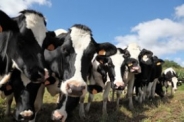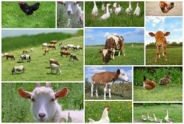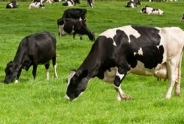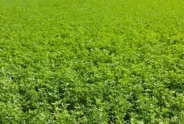Economics of Tile Plow Investment and Use
John Hanchar, Farm Business Management Specialist
Northwest New York Dairy, Livestock & Field Crops
July 8, 2013
In an article of the February 2011 issue of AgFocus, James Kingston reviewed the topic of tractor-drawn tile plows. The article utilized data from presentations that he made at the NWNY Dairy, Livestock, and Field Crops Program's 2011 Corn Congresses in January. In the article, James included a brief summary of some economic analyses that we developed to examine tile plow investment and use. The purpose of this article is to provide more detailed information from those economic analyses. For the detailed analyses, including the MS Excel Spreadsheet developed to examine tile investment and use, please visit the team's website at www.nwnyteam.org and click on "AgFocus."
SummaryPartial budget analyses for profit indicated that 16 of the 20 expected feet installed annually, expected tile contractor charge combinations yielded expected increases to profit (Table 1). Net present value analyses indicated that of 14 of the 20 expected feet installed annually, expected tile contractor charge combinations yielded net present values greater than 0. Net present values greater than or equal to 0 reflect capital investments that would be considered attractive to the producer (Table 2).
Refer to Table 1 below
Overall, analyses suggest that if a producer can expect to install about 16,000 feet of tile or more annually over 5 years, then investment and use of a tractor pulled tile plow is attractive given expected contractor charges of about $0.65 per foot or greater.
Refer to Table 2 below
Tractor Drawn Tile Plows
Considering Costs to the Producer of Realizing Savings in Contractor ChargesA review of information sources prior to developing the economic analyses produced material that enthusiastically described the money that can be made using owned machinery and labor versus hiring a contractor. One example noted $4,000 made in one afternoon ($0.50 per foot excluding tile, the contractor charge avoided, times 8,000 feet installed). Although the savings are notable, the analysis seems to ignore that a farmer would expect to incur additional ownership costs (depreciation, interest, insurance and others) and operating costs (hired labor, machinery repairs and maintenance, fuel, oil and lube expense, and others) associated with tile plow investment and use. The purpose of our analysis was to evaluate the expected benefits and costs associated with tile plow investment and use. An important assumption for all of the analyses described below is that the decision to tile has already been made - expected benefits exceeded expected costs. The only decision remaining is whether to have tile installed by a contractor, or install tile using owned equipment and labor supplied by the farm.
Partial Budget AnalysisA partial budget projects the expected change in profit associated with a proposed change in the farm business, for example, investment in and use of a tile plow compared to hiring a contractor. The expected change in profit equals the expected change in total value of production, income minus the expected change in the costs of inputs used in production. With regards to tiling, expected cost savings might be considerable. However, what cost increases will the farmer incur to realize these savings? A partial budget considers all expected changes to income and costs â?? the decreases and the increases.<br><br>Net
Present Value AnalysisNet present value analysis considers the time value of a stream of net cash flows, income over the life of the investment. The time value of money concept results from the fact that individuals, when given the choice, would prefer to receive a dollar today over a dollar received at some future date, for example, a year from now. The net present value of an investment is the sum of the present values for each year's net cash flow less the initial cost of the investment. If the net present value of an investment is greater than or equal to zero, then the investment is attractive to the decision maker. For this analysis, the initial cost of the investment was $33,000 for the tile plow, stringer cart, and control system.
The analyses described here focused on expected changes in profit and net present values of the investment. James' February article mentioned other considerations that help to determine whether tile plow investment and use makes sense for an individual operation.
Economics of Tile Plow Table 1 & 2 (pdf; 185KB)
Upcoming Events
2026 Corn Congress
January 14, 2026
Henrietta, NY
Participant Registration for the 2026 Corn Congress NOW OPEN!
NOW OFFERING 1.5 DEC Recertification CREDITS
2026 Forage Congress
January 28, 2026
Nunda, NY
Register to attend 2026 Forage Congress!
2026 NWNY Dairy Day
February 5, 2026 : NWNY Dairy Day 2026
Perry, NY
Sponsorship and Registration OPEN!
The CCE NWNY Dairy, Livestock and Field Crops team will be holding it's 4th Annual "Dairy Day" on February 5, 2026! We will be bringing the latest in dairy research and hot topics to you with this in-person, 1-day conference.
Announcements
The NWNY Team is Hiring!
The NWNY Dairy, Livestock and Field Crops Team is currently looking for an Area Dairy Management Specialist as well as a Small Farms and Livestock Specialist:The full position descriptions and instructions on how to apply are available here:
Area Dairy Management Specialist: https://academicjobsonline.org/ajo/jobs/31178
Small Farms and Livestock Specialist: https://academicjobsonline.org/ajo/jobs/30979
Follow us on Instagram
See photos and reels of our most recent events and programs!Join us on Facebook!
Follow us on Facebook to get up to date posts about events, workshops and everything NWNY!Add us on LinkedIn!
Connect with us on LinkedIn to get more information about upcoming workshops and programs!





